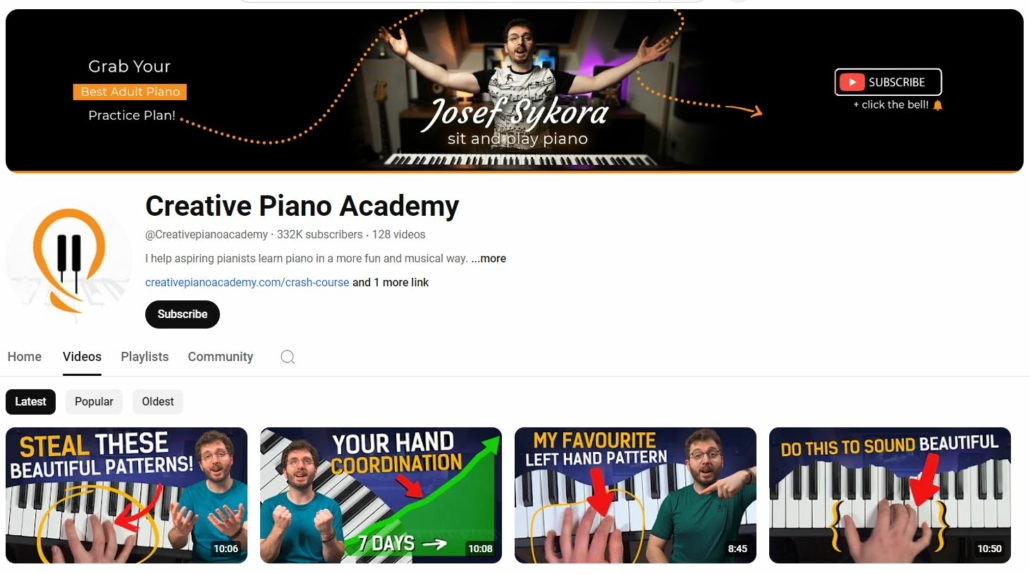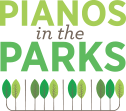Learn to Play Piano Online Quickly for Beginners (Comprehensive Guide 2024)
Have you ever dreamed of playing your favorite songs on the piano? Learning to play piano online has become incredibly accessible and convenient in 2024. This comprehensive guide from Pianos in the Parks will equip you with all the knowledge, the best online learning methods, and how you can take advantage of them to become a proficient piano player.
See More:
- Exploring 5+ Best Piano for Beginners Sheet Music
- Piano Chords for Beginners
- How to Play Piano for Beginners
- 12+ Benefits of Playing Piano

Choosing the Right Online Learning Platform
Not all platforms are created equal, so it’s important to choose the right one that suits your needs. Here are some top ways to learn piano online for you to consider:
1. YouTube Lessons – Fast and Free Learning
YouTube is one of the best places to start if you want quick piano lessons without spending any money. Many channels offer high-quality content for beginners, making it an excellent resource to learn piano online.
How to Start with YouTube:
- Find Beginner Playlists: Look for channels like Creative Piano Academy or Piano Lessons on the Web. They have playlists designed for beginners that cover everything from basic finger exercises to playing popular songs.
- Start with Simple Songs: If you’re a complete beginner, try learning easy songs like “Twinkle, Twinkle, Little Star” or “Happy Birthday.” These songs help you get comfortable with the keys and build muscle memory.
- Practice Regularly: It’s essential to practice along with the videos. Start with simple songs and gradually move to more advanced lessons. Don’t skip lessons, as they are usually organized to help you build a solid foundation.
- Combine Lessons: You can use YouTube to learn specific songs while following other structured learning methods. This helps you stay engaged and apply what you’ve learned.

Pros:
- Learn piano online free with quality content
- Lots of variety in songs and techniques
Cons:
- No structured curriculum or feedback
- Can be overwhelming to find the right starting point
2. Interactive Learning Apps – Fun and Engaging
If you enjoy gamified learning, apps like Skoove, Simply Piano, Yousician, and Flowkey are perfect for you. These apps turn your practice sessions into a game by offering real-time feedback and tracking your progress. They also offer a wide variety of lessons to learn to play piano online, including classical, pop, and jazz styles.
How to Get Started with Apps:
- Download the App: You can find these apps on both Android and iOS platforms. Once installed, connect your digital piano or keyboard to the app.
- Connect Your Piano: Most apps work best when connected to a digital piano or keyboard. This allows the app to provide feedback on your playing.
- Follow Step-by-Step Lessons: The app will guide you through beginner lessons, helping you learn how to play simple songs and develop good techniques.
- Set Daily Goals: Most apps allow you to set daily practice targets, ensuring you stay consistent and motivated. You can also monitor your improvement over time and earn rewards as you progress.

Pros:
- Real-time feedback on your playing
- Fun and engaging lessons
- Progress tracking
Cons:
- Limited free content (most apps require a subscription for full access)
- May not cover advanced music theory
3. Structured Online Courses – Comprehensive Learning
If you’re serious about learning to play piano online and want a structured approach, online courses are a great option. Platforms like Udemy, Playground Sessions, and Pianote offer courses for all skill levels.
Getting Started with Online Courses:
- Sign Up for a Course: Choose a course based on your current skill level. Most platforms categorize their courses for beginners, intermediate players, and advanced learners. Udemy, for instance, offers over 2000 piano courses. Courses on Udemy often have discounts, so you can find high-quality lessons at a reasonable price.
- Follow the Curriculum: Each course is divided into lessons that cover everything from reading sheet music to learning different piano styles. Follow the curriculum closely to ensure steady progress.
- Join the Community: Most platforms offer access to forums or communities where you can ask questions, share your progress, and get feedback from instructors or peers.
Pros:
- Comprehensive lessons with a clear structure
- Access to professional instructors and feedback
- Often includes both video and written resources
Cons:
- Requires a financial investment
- May lack real-time interaction unless you opt for live sessions
4. Private Online Lessons – Personalized Learning
Private online piano lessons are ideal if you want personalized attention from a teacher. You get one-on-one guidance, which allows for tailored lessons based on your learning speed and goals. This is a great option if you’re exploring how to learn piano at home.
How to Start with Private Lessons:
- Find an Instructor: Use platforms like Lessonface or TakeLessons to find experienced piano teachers who offer online lessons.
- Schedule Lessons: Typically, private lessons are held once or twice a week. Ensure that you practice in between sessions to make the most out of each lesson.
- Focus on Your Weaknesses: One of the biggest benefits of private lessons is the ability to focus on areas where you need the most help, such as sight-reading or hand positioning.
- Practice Between Sessions: Private lessons are usually once or twice a week, so it’s important to practice regularly between sessions to reinforce what you’ve learned.

Pros:
- Personalized feedback and lesson plans
- Direct interaction with a professional teacher
- Ability to tailor lessons to your goals
Cons:
- More expensive than other learning methods
- Limited lesson time, usually once a week
Combine Methods for Best Results
For the quickest path to piano proficiency, combining multiple learning methods can be the most effective approach to learning to play piano online. Use YouTube for quick song tutorials, apps for daily practice, and online courses for a deeper understanding of piano theory and technique. This hybrid approach ensures you cover all aspects of learning, from theory to practical skills.
How to Combine Methods:
- Use YouTube for Quick Song Learning: When you want to learn a specific song, search for a tutorial on YouTube.
- Rely on Apps for Daily Practice: Use interactive apps to develop finger strength and coordination through regular practice.
- Follow Online Courses for Theory and Structure: Structured online courses will give you the foundation needed to understand music theory and read sheet music.
- Take Private Lessons for Tailored Guidance: If you hit a roadblock or want feedback on your progress, consider scheduling a few private lessons to get personalized advice.
Essential Equipment for Learning Piano Online
To ensure an effective learning experience, it’s essential to have the right equipment when you start to learn piano online:
- Digital Piano or Keyboard: Opt for a digital piano with weighted keys for a more authentic feel. If you’re using a keyboard, make sure it has at least 61 keys to cover a wide range of music.
- Headphones: Practice without disturbing others by using high-quality headphones. This also helps you focus on the details of your playing.
- Metronome: A metronome helps you maintain a steady rhythm, which is crucial for developing timing and consistency.
- Music Stand or Tablet Holder: Keep your sheet music or digital device at eye level to maintain good posture while practicing.
By using the right tools and resources, you can efficiently learn piano online free or with affordable paid options, building your skills quickly and effectively.
Conclusion
Learning to play piano online is a rewarding journey. With the right resources and dedication, you can achieve your musical goals. Remember, consistency is key. Enjoy the learning process, and don’t forget to celebrate your progress along the way. Choose the method that works best for you and learn piano online today!




Leave a Reply
Want to join the discussion?Feel free to contribute!